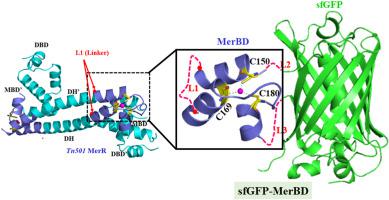Analytica Chimica Acta ( IF 5.7 ) Pub Date : 2023-03-04 , DOI: 10.1016/j.aca.2023.341049 Dan Wang 1 , Liudan Wei 2 , Jiaxin Tan 3 , Yiyu Yan 3 , Min Wei 3 , Tianyu Song 3 , Sihang Li 3 , Liu Zhao 3 , Weibo Wu 3 , Zhipeng Li 4 , Qingyou Liu 4

|
At present, few genetically encoded fluorescent probes are currently available for the analysis of toxic heavy metal ions, and most have poor performance that cannot meet the requirements of sensitive and dynamic detection in living cells. In this study, we designed a single fluorescent protein-based probe sfGFP-MerBD, which can specifically response to Hg2+ with high binding affinity and wide dynamic range. More importantly, the developing probe can timely and reversibly monitor changes of Hg2+ concentration in living mammalian cells. The excellent performance of this probe is largely due to the recognition element of the probe, MerBD, which adopts an unusual planar trigonometric coordination configuration with Hg2+, and the coordination can cause enough conformational change to influence the fluorescence of skeleton protein sfGFP coupled with it. The small peptide MerBD was delicately designed based on the three-dimensional structure of metalloprotein MerR. This novel design strategy solves the challenging problems that there are few natural functional proteins in the process of constructing fluorescent probes for toxic metal ions and some functional proteins cannot be directly used as recognition elements. Based on the new strategy, more genetically encoded fluorescent probes of toxic heavy metal ions can be efficiently constructed and applied in the future.
中文翻译:

一种用于超灵敏传感 Hg2+ 的工程基因编码探针的新策略,具有异常平面三角配位构型
目前,可用于有毒重金属离子分析的基因编码荧光探针很少,而且大部分性能较差,不能满足活细胞内灵敏动态检测的要求。在这项研究中,我们设计了一种基于荧光蛋白的单一探针sfGFP-MerBD,它可以特异性响应Hg 2+,具有高结合亲和力和宽动态范围。更重要的是,开发中的探针可以及时、可逆地监测活体哺乳动物细胞中Hg 2+浓度的变化。该探针的优异性能很大程度上归功于探针的识别元件MerBD,它采用了与Hg 2+不同寻常的平面三角配位构型, 并且协调可以引起足够的构象变化来影响与其耦合的骨架蛋白 sfGFP 的荧光。小肽MerBD是根据金属蛋白MerR的三维结构精心设计的。这种新颖的设计策略解决了在构建有毒金属离子荧光探针过程中天然功能蛋白较少,部分功能蛋白不能直接用作识别元件的挑战性问题。基于该新策略,未来可以高效构建和应用更多毒性重金属离子的基因编码荧光探针。











































 京公网安备 11010802027423号
京公网安备 11010802027423号